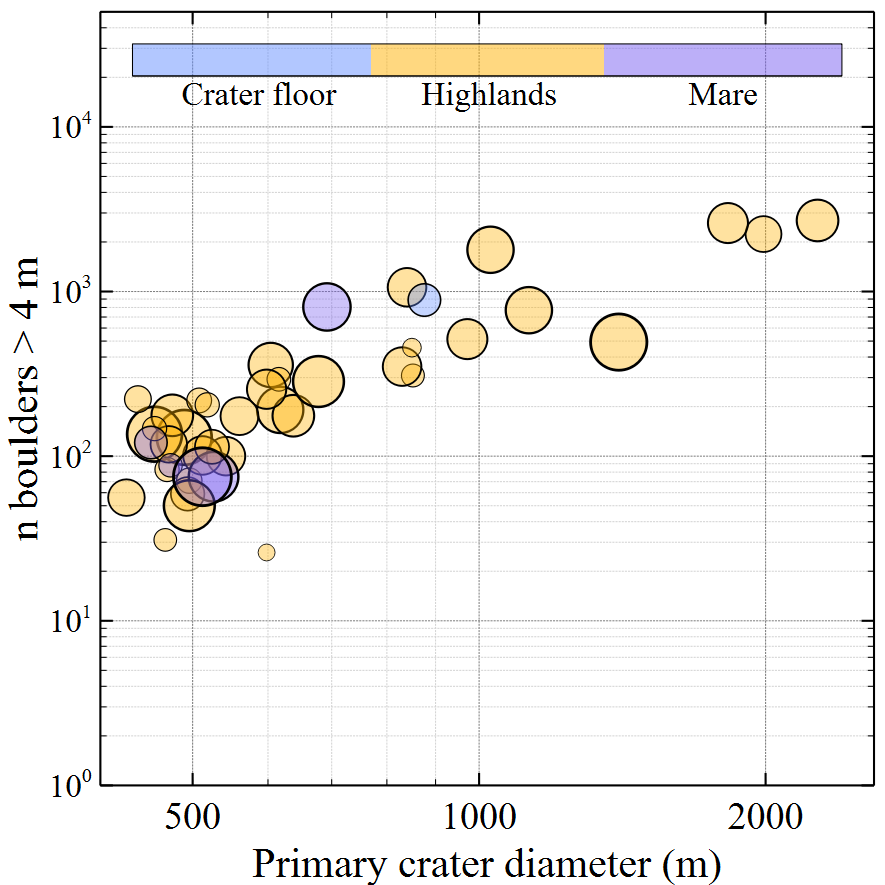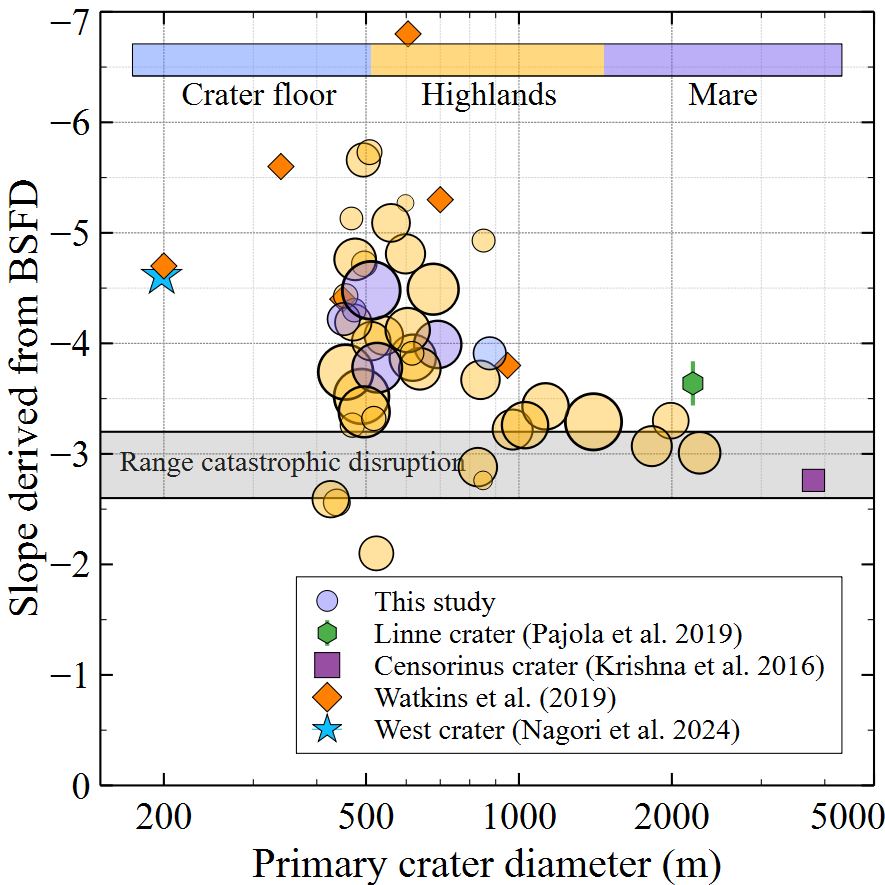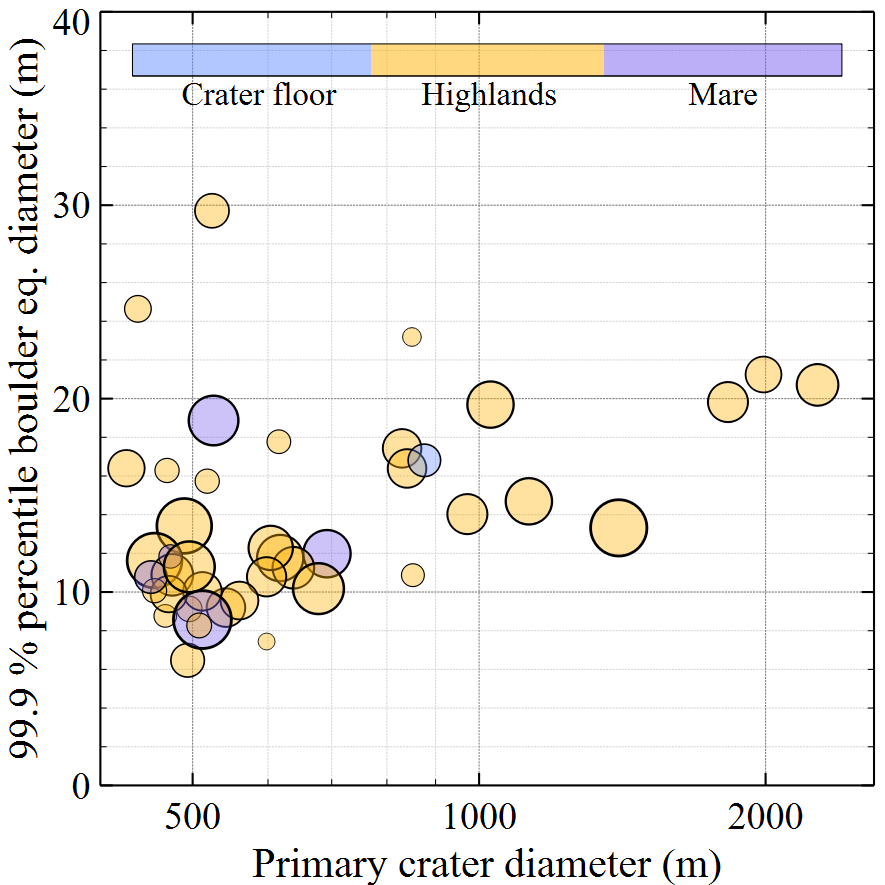Systematic Analysis of Boulder Populations around Lunar Cold Spots
- 1Department of Earth & Planetary Sciences, Stanford University, California, USA
- 2Department of Geosciences, University Oslo, Norway
- 3Sun Yat-Sen University, China
- 4School of Computing & Augmented Intelligence, ASU, Arizona, USA
Introduction: Fragmentation of rocky surfaces upon meteor impacts often generates fields of boulders around impact craters. Ejected boulders sometimes possess sufficient kinetic energy to create secondary craters, increasing overall crater density and introducing biases when estimating crater retention ages. Characterizing the kinetic energy of ejected boulders is required to correct such biases in age determinations [1]. However, the vast number of resolvable boulders around single impact craters has rendered morphometric studies of impact-generated boulders challenging. As a result, few boulder fields have been studied [2–11], impeding systematic analyses of the role of, e.g., impactor energy and target properties on spalled boulder properties. To enable more extensive analyses of boulder morphometrics, we developed BoulderNet [12], a machine learning-based algorithm that automatically detects the boulder outlines and characterizes their morphometrics from high-resolution satellite images. Here, we use BoulderNet around over 40 young and fresh impact structures on the lunar surface (i.e., without visible degradation) to better understand the role of the impactor energy and target properties in the boulder ejection process.
Methods: A couple of improvements to the previously published version of BoulderNet [12] were implemented. First, the model architecture was modified from Mask R-CNN [13] to YOLOv8 [14], leading to refined outline detections (thanks to the anchor-free nature of YOLOv8). Second, boulders around lunar cold spots and fresh impact craters (directly relevant to this study) were added to the training dataset. Overall, these changes resulted in the detection of smaller boulder sizes and an increase in recall and precision for most boulder sizes.
This updated version of BoulderNet was then used to investigate the youngest and freshest impact craters on the lunar surface - the so-called cold spots [15]. Cold spots smaller than 400 m in diameter were excluded from this study because most of their associated boulders are close to or below the limit of resolution of LRO NAC images [16]. A total of 42 cold spots were studied - 5 located in mare, 36 in highlands, and one on the floor of a larger impact crater - with diameters ranging from 420 to 2300 m. Boulder outlines were automatically detected within 1–4 radii away from the crater center. Boulder morphometrics (size, aspect ratio, orientation, spatial density, and location) were then automatically extracted and analyzed.
Fragmentation of rocky materials generates fragment-size populations that roughly follow a power-law distribution, N(>D)=C.D-β, where N is the cumulative number of fragments with diameter > D, and β and C are constants. The slope parameter, β, varies with fragmentation process and history [3]. To further compare boulder populations around cold spots, we fit such a power law for each cold spot (including boulders with diameters greater than 2–4 m depending on image resolution).
Results: As expected, more boulders are generated around larger impacts (Fig. 1). Furthermore, preliminary results suggest that the slope parameter, β, spans a wider range of values for smaller crater diameters (< 1000 m; β ~ -2.5 to -7.0), but clusters around -2.5 to -3.5 for larger craters (Fig. 2). Surprisingly, the correlation between the size of the largest boulders generated by a given impact and crater size is relatively weak (Fig. 3), especially in lunar highlands.

Fig 1. Number of boulders larger than 4 m as a function of primary crater diameter. Only boulders within 1 radius away from the crater rim are selected. Colors reflect terrain type. Symbol size reflects the resolution of NAC images from which detections were made (larger circle = coarser resolution).

Fig 2. Slope parameter, β, of boulder populations around lunar cold spots as a function of primary crater diameter. Results from other studies are also shown for comparison. The range of catastrophic disruption for asteroid collisions is highlighted in gray.

Fig 3. 99.9th percentile of equivalent boulder diameter as a function of primary crater diameter.
Discussion and Conclusions: The general absence of correlation between the size of the largest boulders generated by a given impact and crater size hints at the importance of fragmentation history and the likely presence of pervasive fractures in the lunar crust, especially in highlands. This interpretation is possibly corroborated by our observation of larger variations in β for lunar craters smaller than a kilometer in diameter, which could be explained by more heterogeneous crustal materials in the first tenths of meters. We emphasize that the role of target lithology (mare vs. highlands) is difficult to assess due to the relatively small number of very fresh impact craters therein. To address this caveat, we will analyze boulders around fresh martian craters in similarly young lava flows.
References:
[1] Melosh (1984) Icarus 59.
[2] Shoemaker (1965) JPL Tech. Rept.
[3] Hartmann (1969) Icarus 10.
[4] Vickery (1986) Icarus 67.
[5] Bart & Melosh (2010) Icarus 209.
[6] Krishna et al. (2016) Icarus 264.
[7] Pajola et al. (2017) Icarus 296.
[8] Pajola et al. (2019) PSS 165.
[9] Watkins et al. (2019) JGR Planets 124.
[10] Pajola et al. (2021) Universe 7, 82.
[11] Mistick et al. (2022) Icarus 376.
[12] Prieur et al. 2023, JGR Planets 128.
[13] He et al. arXiv:1703.06870.
[14] Ultralytics: YOLOv8 (2024), https://github.com/ultralytics/ultralytics.
[15] Williams et al. (2018) JGR Planets 123.
[16] Robinson et al. (2010) Space Sc. Rev. 150.
How to cite: Prieur, N. C., Xiao, Z., Kerner, H., Werner, S., and Lapôtre, M.: Systematic Analysis of Boulder Populations around Lunar Cold Spots, Europlanet Science Congress 2024, Berlin, Germany, 8–13 Sep 2024, EPSC2024-1252, https://doi.org/10.5194/epsc2024-1252, 2024.